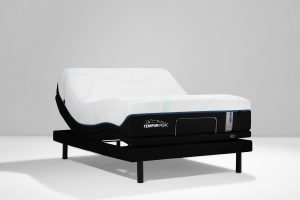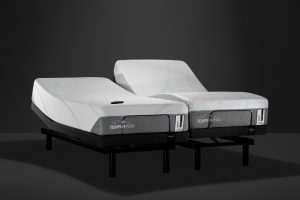
Best Tempur-Pedic Mattress for Herniated Discs
Herniated discs can cause debilitating pain when walking, standing, lying down, and even sleeping. Even minor issues can be cause for concern, as they can lead to more serious problems and even chronic discomfort. The good news is there are many ways to slow this process.
Sleeping correctly on a high-quality mattress is among the best treatment options. Tempur-Pedic mattresses feature a specially designed combination of materials that conform to the body and relieve pressure in key areas. Tempur-Pedic beds are ideal for easing pain, but it is important to determine the best Tempur-Pedic mattress for herniated discs in order to find the relief you need.What is a Herniated Disc?
 Back pain is a common issue impacting up to 80% of humans at some point in their lives. A herniated disc – also called a ruptured, bulging, protruding, or slipped disc – is often the cause of this pain. The spine is made of 24 bones called vertebrae, held in place by jelly-like material. This material, or “discs,” is a soft boundary that protects the bones and nerves in the area. Sometimes, the disc can push through its boundaries, though, causing pressure, inflammation, and pain. Herniated discs typically happen due to age but can result from extreme injury.
Back pain is a common issue impacting up to 80% of humans at some point in their lives. A herniated disc – also called a ruptured, bulging, protruding, or slipped disc – is often the cause of this pain. The spine is made of 24 bones called vertebrae, held in place by jelly-like material. This material, or “discs,” is a soft boundary that protects the bones and nerves in the area. Sometimes, the disc can push through its boundaries, though, causing pressure, inflammation, and pain. Herniated discs typically happen due to age but can result from extreme injury.
Regular exercise and strength training will help build muscles in the back and abdomen and will drastically reduce the risks of slipping a disc.
Bulging Disc Symptoms
The biggest symptom of disc issues is pain in the back, typically toward the lower half. This pain usually lasts a few days and heals on its own. In more extreme cases, slipped discs can lead to numbness and tingling in the legs or feet, weakness in the legs or feet, and even sharp pain in the legs or feet. Some people may even experience loss of bladder or bowel control but this is extremely rare and should be treated by a doctor immediately.Herniated Disc Treatment
Herniated discs often heal on their own and require little attention. There are ways to support the process. Bed rest helps dramatically, as it eases the pressure on the inflamed area. If movement is absolutely necessary, be sure to take breaks often and avoid lifting and bending. Changing your daily routine can help, too, if you focus on using different areas of the body or muscles. In more severe cases, physical therapy may be necessary to strengthen damaged muscles and nerves. Extreme cases may require medical treatment that involves strong medication, steroid injections, or even surgery.Sleeping with a Herniated Lumbar Disc
The ideal amount of sleep each night is seven to nine hours, which is about a third of the day. Because we spend so much time in bed, it is especially important to care for herniated discs during this time.Start by choosing a sleeping position that will ease the pressure on the pain areas but still support the spine.If the disc is herniated in the center of the back, try sleeping on the stomach. If it’s in the lower back, try sleeping on your back with a pillow under your knees. This will ease the pressure on the pain points while keeping the spine aligned. The same can happen by sleeping on your side with a pillow between your legs. This will help align the spine, pelvis, and hips. Ultimately, spinal alignment is the most important factor when sleeping with a herniated disc.
Best Mattress for Herniated Disc and Sciatica
 A lumpy, worn, or overall low-quality mattress can worsen a herniated disc and increase the chances of more back issues. It is crucial to choose a bed that is supportive and contouring to the body. A mattress made from high-quality, long-lasting materials is the best option for healing and avoiding pain.
Tempur-Pedic mattresses are known for their contouring, supportive, and adaptive material. The Tempur foam is designed to shape to the sleeper, then quickly snap back to its original form when pressure is removed. Tempur-Pedic mattresses boast durability and a long lifespan, with high-quality materials that will support a long-term healing process. They also come in varying price points to suit different budgets.
Mattress World Northwest offers a specialized Tempur-Pedic line that includes what is widely considered the best Tempur-Pedic mattress for herniated discs.
[cta id="shop"]
A lumpy, worn, or overall low-quality mattress can worsen a herniated disc and increase the chances of more back issues. It is crucial to choose a bed that is supportive and contouring to the body. A mattress made from high-quality, long-lasting materials is the best option for healing and avoiding pain.
Tempur-Pedic mattresses are known for their contouring, supportive, and adaptive material. The Tempur foam is designed to shape to the sleeper, then quickly snap back to its original form when pressure is removed. Tempur-Pedic mattresses boast durability and a long lifespan, with high-quality materials that will support a long-term healing process. They also come in varying price points to suit different budgets.
Mattress World Northwest offers a specialized Tempur-Pedic line that includes what is widely considered the best Tempur-Pedic mattress for herniated discs.
[cta id="shop"]
TEMPUR-Adapt Collection
The TEMPUR-Adapt line is a top choice for treating back pain. Each Adapt mattress uses unique layers of material that combine to support the body and relieve pressure. The TEMPUR-ES comfort layer offers a softer feel and brings comfort and relaxation to the sleeper. Underneath is the TEMPUR support layer, which is strong yet adaptable, to help hold the sleeper through the night.Tempur-Pedic Pro Adapt Soft
 As the line’s softest option, the Tempur-Pedic Pro Adapt Soft is a good choice for those suffering from herniated discs. It is gentle on the spine while still supportive enough to maintain proper alignment. It comes in sizes from twin to California king, has a 10-year warranty, and starts at $2,699.
As the line’s softest option, the Tempur-Pedic Pro Adapt Soft is a good choice for those suffering from herniated discs. It is gentle on the spine while still supportive enough to maintain proper alignment. It comes in sizes from twin to California king, has a 10-year warranty, and starts at $2,699.
Tempur-Pedic Adapt Medium
The Tempur-Pedic Adapt Medium is the perfect balance of soft and firm mattress options. It is also a less-expensive option, ideal for shoppers with a stricter budget. It comes in sizes from twin to California king, has a 10-year warranty, and starts at $1,499.Tempur-Pedic Adapt Hybrid Medium
 Hybrid mattresses utilize technology from multiple popular mattress styles. The Tempur-Pedic Adapt Hybrid Medium holds 1,000+ premium spring coils in the inner core of the mattress. Support technology surrounds the coil layers. The combination allows sleepers to enjoy the bounce of the traditional coil mattress with the support and durability of the Tempur technology. This mattress is ideal for those seeking pain relief but looking for the familiar feel of a coil bed. The hybrid medium comes in sizes from twin to California king, has a 10-year warranty, and starts at $1,799.
Hybrid mattresses utilize technology from multiple popular mattress styles. The Tempur-Pedic Adapt Hybrid Medium holds 1,000+ premium spring coils in the inner core of the mattress. Support technology surrounds the coil layers. The combination allows sleepers to enjoy the bounce of the traditional coil mattress with the support and durability of the Tempur technology. This mattress is ideal for those seeking pain relief but looking for the familiar feel of a coil bed. The hybrid medium comes in sizes from twin to California king, has a 10-year warranty, and starts at $1,799.

